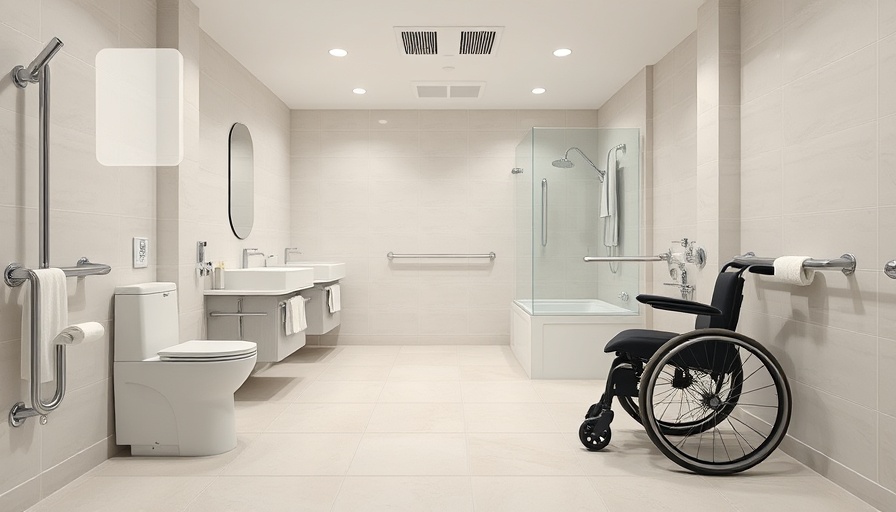
Redefining Accessibility Beyond Compliance
In New Jersey, the conversation about wheelchair accessibility in bathrooms has transformed from simple compliance with the Americans with Disabilities Act (ADA) to a broader aim: ensuring comfort and usability for everyone. As our communities evolve, the need for inclusive design becomes paramount. It's no longer sufficient for businesses to merely meet legal standards; the goal should be to foster an environment where individuals with mobility challenges can navigate spaces with ease and dignity.
Understanding the ADA: A Foundation for Inclusivity
The ADA laid the groundwork for accessibility in public spaces, mandating specific standards regarding the design of facilities, including bathrooms. While compliance is essential to avoid legal repercussions, true inclusivity goes far beyond the basic minimums. The focus must shift towards creating environments tailored to improve the user experience, illustrating the difference between just checking boxes and genuinely accommodating different needs.
Key Features That Make a Difference
To positively impact wheelchair users’ experiences, certain fundamental features must be integrated into bathroom designs. First, consider door width; for optimal maneuverability, doors should have at least 32 inches of clearance. Coupled with a turning radius of 60 inches within the bathroom, users can navigate comfortably.
Aspects that facilitate ease of use also matter significantly. Fixtures like sinks need to be placed at heights accessible to those seated in wheelchairs, while grab bars strategically positioned near toilets and bathing facilities provide support where it’s most needed. Beyond aesthetics, practical solutions such as non-slip flooring prevent accidents, ensuring user safety with every visit.
Innovative Design Trends to Embrace
Modern design philosophies are increasingly prioritizing functionality alongside aesthetics. Automatic doors, capable of opening without manual intervention, are a fantastic innovation. They serve those with limited hand function and enhance user experience immeasurably. Similarly, motion-sensor faucets eliminate the struggle of traditional taps, delivering ease and convenience. As technology advances, incorporating such elements becomes key in bathroom designs that cater to a diverse array of needs.
The Emotional Weight of Accessibility
Accessibility isn't just a matter of convenience; it brings emotional significance too. For individuals with disabilities, a well-designed bathroom can foster feelings of independence and dignity, turning a daunting experience into a comfortable one. Think about the last time you visited a public facility. The subtle nuances—the ability to navigate smoothly, to reach the water faucet without struggle—significantly impact one's sense of belonging within a space. Recognizing this emotional element is crucial in shifting our approach to accessibility.
Future Trends: The Landscape of Bathroom Design
As we look forward, the future of bathroom design must emphasize inclusivity even further. The emphasis on wheelchair accessibility will likely grow, leading to innovations driven by user feedback. Architects and designers will have to consider not just the physical space but the overall experience of navigating it. As awareness of accessibility issues increases, businesses that prioritize comfort will position themselves as leaders in community inclusivity.
Taking Action: The Road Ahead
For architects, designers, and facilities managers, the task ahead is clear: they must champion better standards for wheelchair accessibility in meetings, projects, and public policy discussions. It’s an ongoing commitment that requires collaboration and education. Engaging in conversations about best practices and sharing success stories can forge a path toward a more accessible environment.
For individuals interested in advocating for these changes or seeking to overhaul their own spaces, the potential for community impact is vast. Bringing awareness to the benefits of an inclusive design will help elevate the conversation, positioning accessibility not as a legal obligation, but as a collective responsibility.
If you’re passionate about creating an accessible world for all, now is the time to act. Embrace the knowledge of what makes a bathroom truly accommodating. Whether you’re a business owner looking to meet compliance or an advocate seeking to educate others, understanding the importance of comfort and usability is key to fostering inclusivity.
 Add Row
Add Row  Add
Add 




 Add Row
Add Row  Add
Add 

Write A Comment